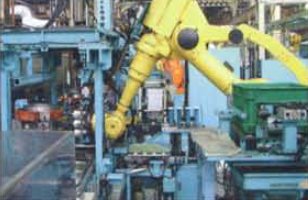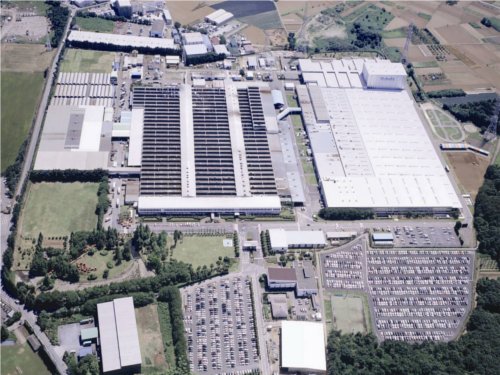A Look at Kubota’s Tsukuba Factory
Photo credit: Kubota Canada click here for larger view
Big Facilities
Kubota has three engine building facilities: Sakai, Sakai Rinkai and Tsukuba plants – named after the cities in which they reside. All are located in Japan on the eastern coast and all are of substantial size. The Sakai plant has been around since before World War II and employs more than 2100 people. The Tsukuba plant, pictured above, covers the largest area at around 83 acres or the same size as 63 American football fields.
These plants in Japan serve as both the facilities for Kubota equipment and engine building. There are research and development centers on site as well as engine emissions testing and compliance labs. Kubota is very keen on meeting and exceeding United States EPA (Environmental Protection Agency) standards. In the photo above it even looks like there is testing area for equipment on the green space bottom left – one can definitely see orange equipment dotted about.
State-Side Operations
All told, the three plants in Japan employ more than 3300 people. In addition, Kubota has two more plants state-side in Georgia, Jefferson and Gainesville. These plants are actually only about a 30 minute drive from one another and together employ another 1700. The Gainesville plant supplies one third of all equipment sold in the United States and manufactures the RTV, BX, lawn tractor and Kubota’s zero-turn models. The smaller Jefferson plant opened in February of 2006, employs 500 and primarily manufactures implements – loaders and backhoes – about 70,000 of them a year!
Serious About Engine Building
Kubota has been known to manufacture tractors for other organizations but some folks do not know that Kubota builds and sells engines not just for their own equipment. You can find Kubota engines in Bobcat, Skylift, Ingersol, Cub Cadet and a ton of other skid steers, mini track-hoes, free standing generators, marine applications, light panels and refrigeration units. It is Kubota’s Industrial Engine Division that handles this demand.
Kubota has dealers that are engine-only and do not have tractors or implements on the showroom floor. Northern Power Products is an example of such a dealership.
Tsukuba the City
The city that resides nearby Kubota’s plant, to the east, actually itself has some history. It is the result of a planned city that Japan started back in the 1960s. The Japanese government has bred the area into sort of a scientific hot spot with numerous research labs, two universities and around 240 private research facilities – all of this in a city of only about 200,000 people. About 50% of Japan’s research and development budget goes to the area. The city hosted the 1985 Expo and has its own very high tech transit system. Read more about it at Wikipedia.
Tsukuba Facility
The Tsukuba plant was built in 1975 and employs about 600 and Kubota manufactures its Super Three series of engines at this plant. The rumors you have heard regarding Japan, robots and a quest for efficiency is true – one third of the assembly line is automated. 15 robots perform basic engine assembly: crankcases, crank gear, pistons, connecting rods – all assembled automatically. 16 CNC robots perform the high precision task of machining engine blocks which leads to improved consistency and quality across the line.

A robot installs pistons on Kubota's automated assembly line.
Unfortunately we are not allowed to see inside the facility, but, we are still able to see what it looks like from space! Use Google Maps below to explore the Tsukuba facility from a satellite’s perspective. This will have to do until next time we are in the neighborhood to take pictures in person!
View Larger Map
Related Articles
Kubota’s Super Three Engine Series





